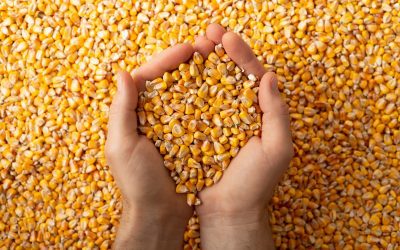Soy Connext brings together more than 600 international buyers and sellers of U.S. Soy
Posted: November 2, 2022
Category:
Indiana Corn and Soybean Post - Fall 2022, ISA, News
Soy Connext is the U.S. Soybean Export Council’s (USSEC) premier annual summit, bringing together U.S. soybean farmers, international customers of U.S. Soy and industry leaders to build stronger relations and partnerships. With inflation rising around the world, the Russian invasion of Ukraine and other geopolitical shocks, this year’s gathering was more important than ever.
More than 600 international buyers and sellers of U.S. Soy, representing more than 60 countries, convened in San Diego, Calif. for the Aug. 22-24 event.

Attendees heard from 30 speakers who delivered invaluable insights into market trends, new innovations that can alleviate the impact of climate change, the role of soy in transforming nutrition around the world, and opportunities for farmers of U.S. Soy to meet growing global demand for soybeans.
Geopolitical risks
A clear theme at this year’s Soy Connext event was the mix of challenges currently facing the industry.
Anja Manuel, co-founder and partner at Rice, Hadley, Gates & Manuel LLC, a strategic consulting firm that helps U.S. companies navigate international markets, offered a warning to “buckle your seatbelts” as geopolitical uncertainties continue to create great uncertainty.
She told the audience that business could be difficult to predict and plan as a result of the Russian invasion of Ukraine and that Chinese demand – while still growing – was slowing from a previously strong pace. Furthermore, Manuel said populist governments around the world are retreating from globalization, putting at risk trade and open borders.
However, while these risks are significant, Manuel said it was also a chance for U.S. Soy farmers to readjust. Instead of focusing on one export market such as China, farmers should look at exporting to 8-10 different markets. “We talked about Southeast and South Asia. These are smaller countries – not as big as China by itself – but they are fastgrowing, great new middle classes,” Manuel said. “There are international markets out there. It’s just going to take more persistence to find them and continue being in the international system.”
Inflation is also causing headaches across the board, creating pressures for both farmers and buyers of U.S. Soy as costs increase. Addressing Soy Connext, Matt Ammermann, commodity risk manager and vice president, Eastern Europe/Black Sea Region for StoneX Financial, said that inflation – along with other pressures – is having an impact on the vegetable oil market, including soybean oil, palm oil, sunflower oil and others.
Ammermann said that in addition to inflation, drought conditions in areas of Europe, the U.S. and China are feeding into the push for clean energy to mitigate climate change. The war in Ukraine is also hurting shipments through the Black Sea region, adding that while there are some ship movements, they are mainly carrying corn and other grains. He said that oil exports will likely remain dependent on the land route and increased crush in other parts of Europe.
Opportunities exist
While these challenges confronting the industry are likely to linger for some time, Soy Connext also provided valuable insights into the opportunities that exist.
According to USSEC, global soy consumption has exceeded global soy production for the past three years (2019-22). Additionally, soy consumption and production over the past 20 years has doubled. Soybeans continue to be the United States’ No. 1 food and agricultural export.
“Climatic, economic and geopolitical events are testing the resilience of the global food system. Uncertainty is the word of the day. We are honored that international companies are rewarding soy’s low carbon footprint, optimal nutritional bundle, high refining rate, low refining cost and reliable production and exports by importing record volumes to advance food and nutrition security in the 82 countries we serve,” said Doug Winter, USSEC chair, USB farmer-leader and Illinois farmer.

Marty Ruikka, president of The ProExporter Network, told guests that opportunities also exist in the rapid urbanization that is happening around the world, which is driving the acceleration in trade intensity.
Ruikka said that with about 80 million people moving to cities each year, the dependence on the global commercial food delivery system is growing. He forecast that soy production needs to increase by about 8 million metric tons per year for stocks to stay even, addingthat the U.S. will continue to be a reliable supplier of whole soybeans, soybean meal and soybean oil.
Meanwhile, USSEC sustainability director Abby Rinne announced at the annual conference that the U.S. Soy Sustainability Assurance Protocol (SSAP) has earned Silver Level Equivalence when benchmarked with the Sustainable Agriculture Initiative (SAI) Platform’s Farm Sustainability Assessment (FSA) 3.0. It is the latest third-party recognition of the sustainability of U.S. Soy, joining the European Feed Manufacturers Organization (FEFAC), Global Seafood Alliance: Best Aquaculture Practices — Sustainable Feed, The Consumer Goods Forum, the Tokyo 2022 Olympics and the UK Roundtable on Sustainable Soya, all of which have already positively benchmarked the SSAP.
“This designation is important for international customers of U.S. Soy and holds the potential to expand markets, especially in Europe where demand for FSA designated soybeans is greater,” said Rinne. “The biodiversity, conservation practices, health and welfare, and continuous improvements that U.S. Soy farmers demonstrate every season are the foundations of the SSAP and what helped U.S. Soy achieve verification. Food companies are looking for more ways to demonstrate the sustainability of their supply chains, and U.S. Soy is committed to help them meet their customer and consumer expectations.”
During the event, USSEC also launched the new Soybean Value Calculator, an innovative tool for soybean crushers to calculate and compare the economic value of soybeans from various countries. Customers can enter companyspecific data along with soybean composition and physical factor data to analyze the potential economic benefit of choosing U.S. soybeans over soy of other origins.
The Soy Connext summit also provided an opportunity for international buyers and customers to visit U.S. soybean farms across a dozen soy-producing states to transparently engage with farmers, inspect the crop and discuss challenges, needs and opportunities.



